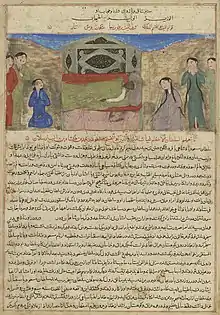Al-Mustarshid
Al-Mustarshid Billah (Arabic: المسترشد بالله) (1092 – 29 August 1135) was the Abbasid caliph in Baghdad from 1118 to 1135. He was son of his predecessor, caliph al-Mustazhir. He succeeded his father in the year 1118 as the twenty-ninth Abbasid Caliph.
| Al-Mustarshid Billah المسترشد بالله | |||||
|---|---|---|---|---|---|
| Khalīfah Amir al-Mu'minin | |||||
| 29th Caliph of the Abbasid Caliphate Abbasid Caliph in Baghdad | |||||
| Reign | 6 August 1118 – 29 August 1135 | ||||
| Predecessor | al-Mustazhir | ||||
| Successor | al-Rashid | ||||
| Born | April/May 1092 Baghdad, Abbasid Caliphate now Iraq | ||||
| Died | 29 August 1135 (aged 43) Baghdad, Abbasid Caliphate now Iraq | ||||
| Consort |
| ||||
| Issue |
| ||||
| |||||
| Dynasty | Abbasid | ||||
| Father | Al-Mustazhir | ||||
| Mother | Lubaba | ||||
| Religion | Sunni Islam | ||||
Biography
Al-Mustarshid achieved more independence as a ruler while the Seljuk sultan Mahmud II was engaged in war in the East. In 1122, al-Mustarshid deposed and imprisoned his vizier Amid al-dawla Jalal al-Din Hasan ibn Ali. Mahmud II then imposed Ahmad ibn Nizam al-Mulk as his vizier.
In 1123, Banu Mazyad general Dubais ibn Sadaqah tried to take advantage of the momentary lack of power and, after plundering Bosra, attacked Baghdad together with a young brother of the sultan, Ghiyath ad-Din Mas’ud (known as Mas'ud) He was however crushed by an army under Zengi and Ahmad ibn Nizam al-Mulk. During the same year, al-Mustarshid removed Ahmad ibn Nizam al-Mulk as his vizier. In 1125, it was the time of al-Mustarshid to rebel. He sent an army to take Wasit but was defeated near Baghdad and imprisoned in his palace the next year.
After the death of Mahmud II, a civil war broke out in the Seljuk western territories. Zengi was recalled to the east by certain rebel members, stimulated by the caliph and Dubais. Zengi was beaten and fled. The caliph pursued him to Mosul, and besieged him there but without success for three months. It was nonetheless a milestone in the revival of the military power of the caliphate.
Zengi now resumed operations in Syria and, in 1134, laid siege to Damascus, but was induced, partly by the bravery of the enemy, partly at the instance of the caliph, to whom Zengi had made some concession in the public prayers, to relinquish the attempt. Recalled again by troubles in the east, he was unable to do much against the Crusaders till after al-Mustarshid's death.

Not long after the siege of Damascus, al-Mustarshid launched a military campaign against Seljuk sultan Mas'ud, who had obtained the title in Baghdad in January 1133 by the caliph himself. The rival armies met near Hamadan. The caliph, deserted by his troops, was taken prisoner, and pardoned on the promising not to quit his palace. Left in the caliphal tent, however, in the sultan's absence, he was found murdered while reading the Quran, as is supposed, by an emissary of the Assassins, who had no love for the caliph. Modern historians have suspected that Mas'ud instigated the murder although the two most important historians of the period Ibn al-Athir and Ibn al-Jawzi did not speculate on this matter.
Physically, al-Mustarshid was a red-haired man with blue eyes and freckles.[1] He was succeeded by his son al-Rashid.
See also
- Ahmad ibn Nizam al-Mulk a Persian vizier of the Abbasid Caliph Al-Mustarshid.
- Anushirvan ibn Khalid a Persian vizier of the Abbasid Caliph Al-Mustarshid served from 1132 to 1134.
- Ahmad Sanjar father-in-law of Abbasid Caliph Al-Mustarshid.
References
Notes
- Amin Maalouf (15 July 2012). The Crusades Through Arab Eyes. Saqi. p. 81. ISBN 978-0-86356-848-0.
Sources
- This text is partly adapted from William Muir's public domain, The Caliphate: Its Rise, Decline, and Fall.
- Hanne, Eric. Putting the Caliph in his Place.
- اغتيال الخليفة المسترشد بالله
Al-Mustarshid Born: 1092 Died: 29 August 1135 | ||
| Sunni Islam titles | ||
|---|---|---|
| Preceded by Al-Mustazhir |
Caliph of Islam Abbasid Caliph 6 August 1118 – 29 August 1135 |
Succeeded by Al-Rashid |